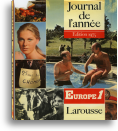Océanie
Australie

Canberra. 13 130 000. 2. 1,9 %.
Économie. PNB (71) 3 228. Production : G (71) 148 + A (72) 115 + I (72) 153. Énerg. (*72) : 5 701. C.E. (71) : 12 %.
Transports. (*72) : 25 608 M t/km. (*72) : 4 273 900 + 1 024 000. : 1 160 000 tjb. (72) : 5 590 M pass./km.
Information. (70) : 58 quotidiens ; tirage global : 4 028 000. (72) : 2 758 000. (72) : 2 939 000. (72) : 478 400 fauteuils. (72) : 4 400 000.
Santé. (71 ) : 16 107. Mté inf. (72) : 16,7.
Éducation. (68). Prim. : 1 768 060. Sec. et techn. : 1 080 524. Sup. : 164 528.
Institutions. Fédération de 6 États (Commonwealth of Australia), indépendante le 1er janvier 1901. Constitution de 1901. Gouverneur général représentant la Couronne britannique : sir Paul Hasluck. Premier ministre : Gough Whitlam.
Fidji (Îles)

Suva. 550 000. 30. 2,5 %.
Économie. PNB (72) 541. Production : G (71) 151. Énerg. (*72) : 518. C.E. (72) : 25 %.
Transports. (*72) : 16 300 + 6 300.
Information. (72) : 1 quotidien ; tirage global : 19 000. (72) : 53 000. (72) : 22 000.
Santé. (71) : 256. Mté inf. (72) : 26,1.
Éducation. (71). Prim. : 126 130. Sec. et techn. : 20 072. Sup. (62) : 467.
Institutions. État indépendant le 10 octobre 1970. Gouverneur général représentant la Couronne britannique : sir Robert Foster. Premier ministre : Kamisese Mara.
Nauru

7 000. 333. 4,3 %.
Économie. Énerg. (*72) : 5 571.
Information. (71) : *4 600. (70) : 1 000 fauteuils ; fréquentation : 907 M.
Santé. (71) : 10. Mté inf. (68) : 51,8.
Éducation. (71). Prim. : 1 118. Sec. et techn. : 364.
Institutions. République indépendante le 31 janvier 1968. Constitution de 1968. Président de la République : Hammer de Roburt. Les Affaires étrangères et la Défense sont assurées par l'Australie.
Nouvelle-Zélande

Wellington. 2 960 000. 11. 1,5 %.
Économie. PNB (71) 2 543. Production : A (72) 124 + I (70) 156. Énerg. (*72) : 2 887. C.E. (71) : 19 %.
Transports. (71) : 528 M pass./km, 2 733 M t/km. (*72) : 990 500 + 200 500. : 157 000 tjb. (72) : 1 490 M pass./km.
Information. (72) : 40 quotidiens. (71) : 713 000. (72) : *726 000. (71) : 140 900 fauteuils ; fréquentation : 14,3 M. (72) : 1 358 000.
Santé. (71) : 3 375. Mté inf. (71) : 16,5.
Éducation. (69). Prim. : 514 774. Sec. et techn. (70) : 186 743. Sup. : 56 353.
Institutions. État indépendant en 1931. Des lois fondamentales tiennent lieu de Constitution. Gouverneur général représentant la Couronne britannique : sir Denis Blundell. Premier ministre : Wallace Rowling, succède à Norman Kirk décédé.
Papouasie-Nlle-Guinée

Port Moresby. 2 560 000. 6. 2,5 %.
Économie. Énerg. (*72) : 188.
Transports. (*72) : 20 100 + 16 600.
Information. (71) : 25 000.
Santé. (71) : 233.
Éducation. Prim. (68) : 65 073. Sec. et techn. (69) : *7 200. Sup. (65) : 506.
Institutions. Accède à l'autonomie interne le 1er décembre 1973, dernière étape vers l'indépendance totale vis-à-vis de l'Australie. Le 16 mars 1975, Mlle Joséphine Abaijah, leader du mouvement sécessionniste, proclame l'indépendance de la Papouasie. Premier ministre : Michael Somare.
Samoa Occidentales

Apia. 150 000. 53. 2,4 %.
Économie. Énerg. (*72) : 117.
Transports. (*72) : 1 500 + 1 100.
Information. (72) : *50 000. (72) : *80. (72) : 1 900 fauteuils ; fréquentation : 0,5 M. (72) : 2 000.
Santé. (71) : 51. Mté inf. (72) : *27,1.
Éducation. (70). Prim. : 29 405. Sec. et techn. : 10 147. Sup. : 114.
Institutions. État indépendant le 1er janvier 1962. Constitution de 1960. Chef de l'État : Malietoa Tanumafili. Premier ministre : Tupua Tamasese Lealofi.
Tonga (ou îles des Amis)

Nukualofa. 90 000. 129. 3,2 %.
Économie. PNB (70) 346.
Information. (72) : *9 000. (69) : 3 600 fauteuils.
Santé. (71) : 28.
Éducation. (70). Prim. : 17 865. Sec. et techn. : 10 159.
Institutions. État indépendant le 4 juin 1970 Monarchie. Souverain : Taufa' Ahau Tupou IV. Premier ministre : prince Tu' Ipelehake.




